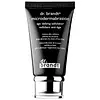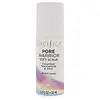What's inside
What's inside
 Key Ingredients
Key Ingredients

 Benefits
Benefits

 Concerns
Concerns

 Ingredients Side-by-side
Ingredients Side-by-side

Water
Skin ConditioningAlumina
AbrasiveCaprylic/Capric Triglyceride
MaskingGlycerin
HumectantCetyl Alcohol
EmollientGlyceryl Stearate
EmollientPEG-100 Stearate
Ammonium Acryloyldimethyltaurate/Vp Copolymer
Simmondsia Chinensis Seed Oil
EmollientXanthan Gum
EmulsifyingPhenoxyethanol
PreservativeLactic Acid
BufferingParfum
MaskingMenthone Glycerin Acetal
RefreshingAllantoin
Skin ConditioningDisodium EDTA
Tocopheryl Acetate
AntioxidantMagnesium Oxide
AbsorbentPropylene Glycol
HumectantAloe Barbadensis Leaf Extract
EmollientVitis Vinifera Seed Extract
AntimicrobialChamomilla Recutita Flower Extract
MaskingCamellia Sinensis Leaf Extract
AntimicrobialCitral
PerfumingLimonene
PerfumingWater, Alumina, Caprylic/Capric Triglyceride, Glycerin, Cetyl Alcohol, Glyceryl Stearate, PEG-100 Stearate, Ammonium Acryloyldimethyltaurate/Vp Copolymer, Simmondsia Chinensis Seed Oil, Xanthan Gum, Phenoxyethanol, Lactic Acid, Parfum, Menthone Glycerin Acetal, Allantoin, Disodium EDTA, Tocopheryl Acetate, Magnesium Oxide, Propylene Glycol, Aloe Barbadensis Leaf Extract, Vitis Vinifera Seed Extract, Chamomilla Recutita Flower Extract, Camellia Sinensis Leaf Extract, Citral, Limonene
Water
Skin ConditioningHelianthus Annuus Seed Oil
EmollientJojoba Esters
EmollientGlycerin
HumectantCetyl Alcohol
EmollientGlyceryl Stearate
EmollientStearic Acid
CleansingBenzyl Alcohol
PerfumingNiacinamide
SmoothingTocopherol
AntioxidantCucumis Sativus Fruit Extract
EmollientRosa Canina Fruit Oil
EmollientLavandula Angustifolia Flower/Leaf/Stem Extract
MaskingChamomilla Recutita Flower Extract
MaskingCamellia Sinensis Leaf Extract
AntimicrobialArnica Montana Flower Extract
MaskingPanthenol
Skin ConditioningSimmondsia Chinensis Seed Oil
EmollientGlycine Soja Sterols
EmollientAllantoin
Skin ConditioningCannabis Sativa Seed Oil
EmollientSalvia Officinalis Oil
MaskingMentha Piperita Oil
MaskingLinum Usitatissimum Seed Oil
PerfumingJasminum Officinale Flower Extract
MaskingColeus Forskohlii Root Oil
EmollientPistacia Lentiscus Gum
MaskingLecithin
EmollientPapain
Skin ConditioningBromelain
Skin ConditioningMaltodextrin
AbsorbentGlyceryl Laurate
EmollientAlcohol Denat.
AntimicrobialDipotassium Glycyrrhizate
HumectantPhenoxyethanol
PreservativeSodium PCA
HumectantEthylhexylglycerin
Skin ConditioningParfum
MaskingWater, Helianthus Annuus Seed Oil, Jojoba Esters, Glycerin, Cetyl Alcohol, Glyceryl Stearate, Stearic Acid, Benzyl Alcohol, Niacinamide, Tocopherol, Cucumis Sativus Fruit Extract, Rosa Canina Fruit Oil, Lavandula Angustifolia Flower/Leaf/Stem Extract, Chamomilla Recutita Flower Extract, Camellia Sinensis Leaf Extract, Arnica Montana Flower Extract, Panthenol, Simmondsia Chinensis Seed Oil, Glycine Soja Sterols, Allantoin, Cannabis Sativa Seed Oil, Salvia Officinalis Oil, Mentha Piperita Oil, Linum Usitatissimum Seed Oil, Jasminum Officinale Flower Extract, Coleus Forskohlii Root Oil, Pistacia Lentiscus Gum, Lecithin, Papain, Bromelain, Maltodextrin, Glyceryl Laurate, Alcohol Denat., Dipotassium Glycyrrhizate, Phenoxyethanol, Sodium PCA, Ethylhexylglycerin, Parfum
Ingredients Explained
These ingredients are found in both products.
Ingredients higher up in an ingredient list are typically present in a larger amount.
Allantoin is a soothing ingredient known for its protective and moisturizingg properties. Because of this, it is often added to products with strong active ingredients.
Studies show higher concentrations of this ingredient can promote wound healing.
Though it can be derived from the comfrey plant, allantoin is produced synthetically for cosmetic products to ensure purity.
Learn more about AllantoinCamellia Sinensis Leaf Extract is derived from the leaves of the tea plant. Black tea, green tea, and oolong tea are all harvested from this plant.
This ingredient has many skin benefits:
This ingredient contains polyphenols, a strong antioxidant. Antioxidants help fight off molecules that damage skin cells.
On top of that, the antioxidants in green tea neutralize free-radicals from the sun. This gives the skin some extra UV protection, but should not replace sunscreen.
Many components of tea have anti-inflammatory properties.
Polyphenols and L-theanine help soothe the skin and reduce irritation. The caffeine in Camellia Sinensis Leaf Extract helps calm inflamed blood vessels.
Other compounds found in tea include: Vitamin Bs, linoleic acid, magnesium, calcium, iron, and zinc.
Research has shown both drinking Camellia Sinensis Leaf Tea and applying it to the skin can help boost skin elasticity and hydration. Studies also show using tea extract may reduce sebum, or oil, production.
Learn more about Camellia Sinensis Leaf ExtractCetyl Alcohol is a fatty alcohol. Fatty Alcohols are most often used as an emollient or to thicken a product.
Its main roles are:
Though it has "alcohol" in the name, it is not related to denatured alcohol or ethyl alcohol.
The FDA allows products labeled "alcohol-free" to have fatty alcohols.
Learn more about Cetyl AlcoholChamomilla Recutita Flower Extract comes from the Chamomile flower.
Chamomile is rich in antioxidants and has anti-inflammatory properties. Several compounds found in chamomile help with soothing, such as bisbolol.
Antioxidant components in chamomile make it an effective ingredient to help slow the signs of aging. Antioxidants help fight free-radical molecules, or molecules that may damage your skin.
Essential oils from chamomile have been found to improve wound healing due to its antimicrobial properties.
Ancient Greeks and Egyptians used Chamomile to treat skin redness and dryness. Chamomile has also been used to help treat stomach issues.
Learn more about Chamomilla Recutita Flower ExtractGlycerin is already naturally found in your skin. It helps moisturize and protect your skin.
A study from 2016 found glycerin to be more effective as a humectant than AHAs and hyaluronic acid.
As a humectant, it helps the skin stay hydrated by pulling moisture to your skin. The low molecular weight of glycerin allows it to pull moisture into the deeper layers of your skin.
Hydrated skin improves your skin barrier; Your skin barrier helps protect against irritants and bacteria.
Glycerin has also been found to have antimicrobial and antiviral properties. Due to these properties, glycerin is often used in wound and burn treatments.
In cosmetics, glycerin is usually derived from plants such as soybean or palm. However, it can also be sourced from animals, such as tallow or animal fat.
This ingredient is organic, colorless, odorless, and non-toxic.
Glycerin is the name for this ingredient in American English. British English uses Glycerol/Glycerine.
Learn more about GlycerinGlyceryl Stearate is a mix of glycerin and stearic acid.
It is used to stabilize the mixing of water and oil ingredients. By preventing these ingredients from separating, it can help elongate shelf life. It can also help thicken the product's texture.
As an emollient, it helps soften skin and supports barrier-replenishing ingredients.
In cosmetics, Glyceryl Stearate is often made from vegetable oils or synthetically produced.
This ingredient may not be fungal-acne safe
Fun fact: The human body also creates Glyceryl Stearate naturally.
Learn more about Glyceryl StearateParfum is a catch-all term for an ingredient or more that is used to give a scent to products.
Also called "fragrance", this ingredient can be a blend of hundreds of chemicals or plant oils. This means every product with "fragrance" or "parfum" in the ingredients list is a different mixture.
For instance, Habanolide is a proprietary trade name for a specific aroma chemical. When used as a fragrance ingredient in cosmetics, most aroma chemicals fall under the broad labeling category of “FRAGRANCE” or “PARFUM” according to EU and US regulations.
The term 'parfum' or 'fragrance' is not regulated in many countries. In many cases, it is up to the brand to define this term.
For instance, many brands choose to label themselves as "fragrance-free" because they are not using synthetic fragrances. However, their products may still contain ingredients such as essential oils that are considered a fragrance by INCI standards.
One example is Calendula flower extract. Calendula is an essential oil that still imparts a scent or 'fragrance'.
Depending on the blend, the ingredients in the mixture can cause allergies and sensitivities on the skin. Some ingredients that are known EU allergens include linalool and citronellol.
Parfum can also be used to mask or cover an unpleasant scent.
The bottom line is: not all fragrances/parfum/ingredients are created equally. If you are worried about fragrances, we recommend taking a closer look at an ingredient. And of course, we always recommend speaking with a professional.
Learn more about ParfumPhenoxyethanol is a preservative that has germicide, antimicrobial, and aromatic properties. Studies show that phenoxyethanol can prevent microbial growth. By itself, it has a scent that is similar to that of a rose.
It's often used in formulations along with Caprylyl Glycol to preserve the shelf life of products.
This oil comes from the seeds of the desert shrub called Jojoba. It is more commonly known as jojoba oil, a non-comedogenic oil.
Jojoba oil does not contain fragrance and has many fatty-acids, making it a great soothing ingredient.
It also contains Vitamin E, a great moisturizing ingredient. Vitamin E is also an antioxidant and protects your skin against oxidative damage.
This ingredient humectant properties, meaning it helps draw moisture from the air. This helps keep your skin hydrated.
While jojoba has antibacterial properties, it is only able to kill some strains of bacteria.
Studies also show it helps in wound healing. In fact, Indigenous cultures have used jojoba as a moisturizer and to help treat burns for centuries.
Fun fact: Jojoba oil similar to natural human skin sebum, so it has a great effect on dry skin. It is also promising with helping to regulate sebum production.
Due to its fatty acid content, Jojoba oil may not be fungal acne safe. We recommend speaking with a professional if you have any concerns.
Learn more about Simmondsia Chinensis Seed OilWater. It's the most common cosmetic ingredient of all. You'll usually see it at the top of ingredient lists, meaning that it makes up the largest part of the product.
So why is it so popular? Water most often acts as a solvent - this means that it helps dissolve other ingredients into the formulation.
You'll also recognize water as that liquid we all need to stay alive. If you see this, drink a glass of water. Stay hydrated!
Learn more about Water